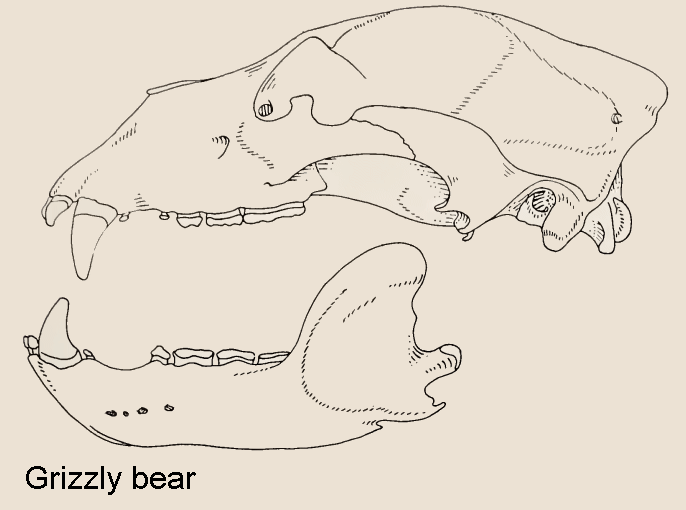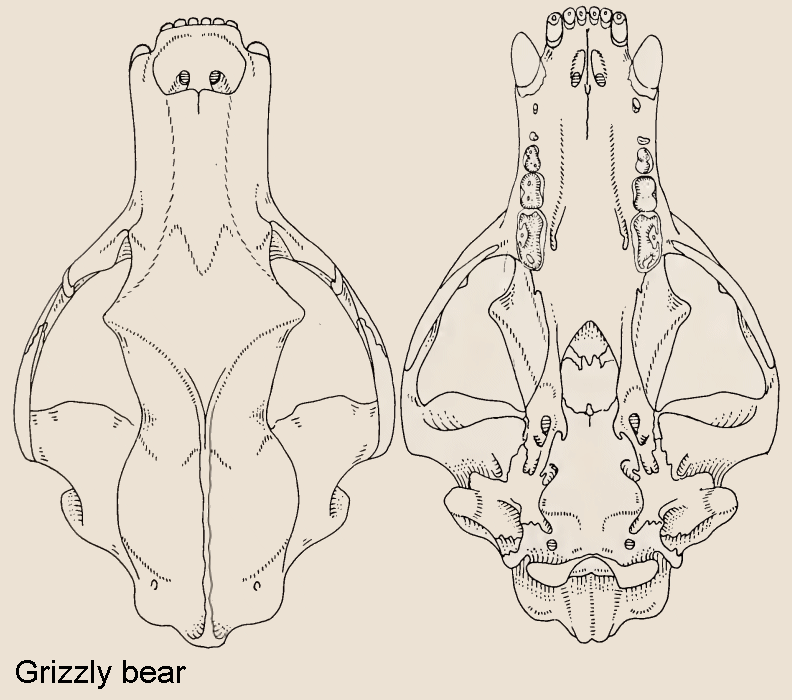It looks like you're using an Ad Blocker.
Please white-list or disable AboveTopSecret.com in your ad-blocking tool.
Thank you.
Some features of ATS will be disabled while you continue to use an ad-blocker.
share:
reply to post by candlestick
i think saying "we are all Humans" is equivalent to a bear saying "we are all Ursus" make sense?
i think saying "we are all Humans" is equivalent to a bear saying "we are all Ursus" make sense?
candlestick
Not by the skin color only ,but I prefer there's a subdivision list as subspecies of bear.
If I understand what you're saying correctly, there's not enough differences between humans to consider more than one subspecies.
Look at the images below, comparing black bears with grizzly bears, and you can see that the differences are bigger than the differences between human skulls (I couldn't find any good drawings for the comparison, maybe someone can provide them).


Most common used differences between black and white humans are the shape of the skull and the angle of the part of the skull between the nose and the upper teeth, and those are small differences that may be mixed in some people and cannot really be considered specific for a particular type of human. That's why it's easier to identify the sex of a human skeleton than identify if it's from a black or white (or other variation) person.
PS: I just measured my skull to get my cephalic index, as that's one way of classifying human skulls, and I found out that I am neither "dolichocephalic" or "brachycephalic", I'm what they call "mesocephalic".
pryingopen3rdeye
reply to post by candlestick
i think saying "we are all Humans" is equivalent to a bear saying "we are all Ursus" make sense?
Ursus is the genus name ,then we should say "we are all homo"(genus name ).
LOL
ArMaP
candlestick
Not by the skin color only ,but I prefer there's a subdivision list as subspecies of bear.
If I understand what you're saying correctly, there's not enough differences between humans to consider more than one subspecies.
Look at the images below, comparing black bears with grizzly bears, and you can see that the differences are bigger than the differences between human skulls (I couldn't find any good drawings for the comparison, maybe someone can provide them).
Most common used differences between black and white humans are the shape of the skull and the angle of the part of the skull between the nose and the upper teeth, and those are small differences that may be mixed in some people and cannot really be considered specific for a particular type of human. That's why it's easier to identify the sex of a human skeleton than identify if it's from a black or white (or other variation) person.
PS: I just measured my skull to get my cephalic index, as that's one way of classifying human skulls, and I found out that I am neither "dolichocephalic" or "brachycephalic", I'm what they call "mesocephalic".
But black bears and grizzly bears are different species.Grizzly bear is subspecies of the brown bears.You can't use different SPECIES bears skull to proof " there's not enough differences between humans to consider more than one SUBSPECIES .".
en.wikipedia.org...
This emoticon is cute.
There's some different human skulls.
www.theoryofuniverse.com...
edit on 13-4-2014 by candlestick because: (no reason given)
candlestick
pryingopen3rdeye
reply to post by candlestick
i think saying "we are all Humans" is equivalent to a bear saying "we are all Ursus" make sense?
Ursus is the genus name ,then we should say "we are all homo"(genus name ).
LOL
lol!
ok then so, "we are all bears" equivalent?
woogleuk
Maybe our physical differences come from the fact that white people are mongrels, a cross between homo-sapiens, Homo-erectus and Neanderthals.
Black people are probably the only true homo-sapiens around.
As strange as that may sound to some it's pretty darn close imho. The vast majority of people on the planet have a mixture of either Neanderthal or Denisovian dna buried in their genes except for those original sub Saharan Africans.
candlestick
Oh,so if you are a scientist and you find a new subspecies of human ,that is your reason to hate?That sounds like a racist for me.Haters always hate.And I never say we should hate a new subspecies on the thread.

I read somewhere (maybe someone can confirm) that there is more genetic variation in humans than there is between all the dog breeds. Sounds
plausable but unintuitive. And yes, Candlestick I own and enjoy firearms but that's not the reason for my avitar...I just love Clint Eastwood
westerns. ESP. The Outlaw Jose Wales :-)
Astyanax
reply to post by EdSurly
Political correctness? You're barking up the wrong tree, gun boy. I work for the Stupidity Police.
Your reply proves otherwise.
candlestick
But black bears and grizzly bears are different species.Grizzly bear is subspecies of the brown bears.You can't use different SPECIES bears skull to proof " there's not enough differences between humans to consider more than one SUBSPECIES .".
Well, I used black bears and grizzly bears because
There's many species and subspecies on the Ursus page ,I saw black bear and brown bear are not a same species.Because their color are different?
There's some different human skulls.
www.theoryofuniverse.com...
Thanks, but I was looking for scientific drawings, not photos of specific skulls.
edit on 14/4/2014 by ArMaP because: change "that's what you used" to "you used black bears and brown bears"
aren't we homo sapien sapien?
homo sapien includes neanderthal.
homo sapien includes neanderthal.
tsingtao
aren't we homo sapien sapien?
homo sapien includes neanderthal.
Yes, we are. Homo Sapiens includes Neanderthal, like you said, and we are a subspecies of Homo Sapiens called Homo Sapiens Sapiens.
To me that answers the question: we are all a subspecies of Homo Sapiens, regardless how different we may look on the outside as there is a very small genetic variation. We have adapted our features according to the environment but we are all the same subspecies: Homo sapiens sapiens.
By the way, Homo Sapiens means Wise Men, Homo means Man.
Agartha
tsingtao
aren't we homo sapien sapien?
homo sapien includes neanderthal.
Yes, we are. Homo Sapiens includes Neanderthal, like you said, and we are a subspecies of Homo Sapiens called Homo Sapiens Sapiens.
To me that answers the question: we are all a subspecies of Homo Sapiens, regardless how different we may look on the outside as there is a very small genetic variation. We have adapted our features according to the environment but we are all the same subspecies: Homo sapiens sapiens.
By the way, Homo Sapiens means Wise Men, Homo means Man.
Is it possible for modern humans to adapt/evolve to a point of being subspecies between them? Can you describe what some characteristics may be like in order for that to happen?
ImaFungi
Is it possible for modern humans to adapt/evolve to a point of being subspecies between them?
In principle, yes. Why wouldn't it? We're life, after all.
Can you describe what some characteristics may be like in order for that to happen?
That would depend entirely on the different environmental pressures acting on the different populations.
ImaFungi
Is it possible for modern humans to adapt/evolve to a point of being subspecies between them? Can you describe what some characteristics may be like in order for that to happen?
Like the poster above said, yes, we are a lifeform and can change drastically, but it would take at least a couple of million years for some subspecies of our subspecies to appear. So far we have only changed our features to adapt to the climate, but have not changed genetically. Maybe in the future we will, who knows?
Maybe people in very polluted areas will grow a third lung? (to process more oxygen). This is a first example of a possible natural evolution....it all depends on the environment I guess.
A couple of ideas on this subject. First, DNA bar coding (see article at the bottom) could possibly be the future of defining a "species". But as
the following articles show, it ain't that easy!
"For example, after full genome sequences of humans and several apes became available, scientists were eager to find out what genes set us apart from our closest living relative, the bonobo. Researchers thus compared the two sequences to establish the amount and type of genetic variation. It turns out that the human and ape genomes are remarkably similar; in fact, a recent comparison of the two found a nucleotide divergence of only 1.23% (Mikkelsen et al., 2005). To better appreciate the scale of this variation, consider the fact that African and European human populations exhibit 0.08% nucleotide divergence (Yu et al., 2002). Knowing that all genes do not evolve at the same rate, researchers were also able to isolate those human alleles that have undergone the most change since the human and ape lineages split about 2 million years ago. This knowledge was then used to determine our rate of evolutionary divergence from the great apes, thus helping calibrate the molecular clock used to build the primate family tree. "
www.nature.com...
And this on the sequencing of Neanderthal DNA:
"A tantalizing finding is that, when all substitutions in the mtDNA are analyzed, the Neandertal mtDNA lineage is shorter than the human lineage by approximately 20% (Figure S3B). It is tempting to speculate that this is due to the fact that the Neandertal mtDNA is ∼38,000 years older than the extant human mtDNA sequences to which it is compared. However, under the assumption that the evolutionary dates are reasonably accurate, the reduction in length is about three times as large as would be expected if it was entirely due to the age of the fossil. It should be noted that, for small evolutionary distances such as these, there is a large stochastic component to phylogenetic branch length. Thus, although the evolutionary dates are clearly dependent on many tenuous assumptions, it seems reasonable to assume that the majority of the discrepancy in length between the Neandertal and extant human mtDNA lineages is due to stochastic differences in the amounts of substitutions that have come to fixation on the two lineages."
NOTE mtDNA is mitochondrial DNA - passed on by the female
www.sciencedirect.com...
The problem of defining a "species" seems to get more complex as more research unfolds. If the survival of a particular species is dependent on adaptive genetic mutation, then there's definitely a foggy area where there's going to be a blur between species. I'm not a taxonomist - and I don't think I'd want to be one with all the confusion on the definition of species.
Interesting comments on "bar coding" here - maybe we'll find that we are all really evolutionary derivatives of the same organism.
www3.imperial.ac.uk...
"For example, after full genome sequences of humans and several apes became available, scientists were eager to find out what genes set us apart from our closest living relative, the bonobo. Researchers thus compared the two sequences to establish the amount and type of genetic variation. It turns out that the human and ape genomes are remarkably similar; in fact, a recent comparison of the two found a nucleotide divergence of only 1.23% (Mikkelsen et al., 2005). To better appreciate the scale of this variation, consider the fact that African and European human populations exhibit 0.08% nucleotide divergence (Yu et al., 2002). Knowing that all genes do not evolve at the same rate, researchers were also able to isolate those human alleles that have undergone the most change since the human and ape lineages split about 2 million years ago. This knowledge was then used to determine our rate of evolutionary divergence from the great apes, thus helping calibrate the molecular clock used to build the primate family tree. "
www.nature.com...
And this on the sequencing of Neanderthal DNA:
"A tantalizing finding is that, when all substitutions in the mtDNA are analyzed, the Neandertal mtDNA lineage is shorter than the human lineage by approximately 20% (Figure S3B). It is tempting to speculate that this is due to the fact that the Neandertal mtDNA is ∼38,000 years older than the extant human mtDNA sequences to which it is compared. However, under the assumption that the evolutionary dates are reasonably accurate, the reduction in length is about three times as large as would be expected if it was entirely due to the age of the fossil. It should be noted that, for small evolutionary distances such as these, there is a large stochastic component to phylogenetic branch length. Thus, although the evolutionary dates are clearly dependent on many tenuous assumptions, it seems reasonable to assume that the majority of the discrepancy in length between the Neandertal and extant human mtDNA lineages is due to stochastic differences in the amounts of substitutions that have come to fixation on the two lineages."
NOTE mtDNA is mitochondrial DNA - passed on by the female
www.sciencedirect.com...
The problem of defining a "species" seems to get more complex as more research unfolds. If the survival of a particular species is dependent on adaptive genetic mutation, then there's definitely a foggy area where there's going to be a blur between species. I'm not a taxonomist - and I don't think I'd want to be one with all the confusion on the definition of species.
Interesting comments on "bar coding" here - maybe we'll find that we are all really evolutionary derivatives of the same organism.
www3.imperial.ac.uk...
edit on 14-4-2014 by Phantom423 because: (no reason given)
new topics
-
Ed Dowd some good news
Medical Issues & Conspiracies: 56 minutes ago -
Anyone like the Scorpions?
Music: 1 hours ago -
What if this is true?
2024 Elections: 2 hours ago -
Merry-Go-Round Ride
Short Stories: 3 hours ago -
It's toast
General Chit Chat: 7 hours ago -
Man Stabbed or Cardiac arrest on Westminster Bridge, London, UK
Mainstream News: 9 hours ago -
A fix for the Trans players in sports
Social Issues and Civil Unrest: 11 hours ago
top topics
-
Petition Calling for General Election at 564,016 and rising Fast
Political Issues: 14 hours ago, 14 flags -
A fix for the Trans players in sports
Social Issues and Civil Unrest: 11 hours ago, 14 flags -
Man Stabbed or Cardiac arrest on Westminster Bridge, London, UK
Mainstream News: 9 hours ago, 7 flags -
It's toast
General Chit Chat: 7 hours ago, 7 flags -
What if this is true?
2024 Elections: 2 hours ago, 7 flags -
Merry-Go-Round Ride
Short Stories: 3 hours ago, 5 flags -
Anyone like the Scorpions?
Music: 1 hours ago, 3 flags -
Ed Dowd some good news
Medical Issues & Conspiracies: 56 minutes ago, 3 flags
active topics
-
France gives Ukraine license to fire long-range missiles at Russia
World War Three • 39 • : WeMustCare -
What if this is true?
2024 Elections • 17 • : WeMustCare -
Anyone like the Scorpions?
Music • 2 • : Flyingclaydisk -
Ed Dowd some good news
Medical Issues & Conspiracies • 0 • : annonentity -
Merry-Go-Round Ride
Short Stories • 5 • : randomuser2034 -
Results of the use of the Oreshnik missile system in Dnepropetrovsk
World War Three • 217 • : worldstarcountry -
Russia Ukraine Update Thread - part 3
World War Three • 6876 • : worldstarcountry -
Petition Calling for General Election at 564,016 and rising Fast
Political Issues • 65 • : Oldcarpy2 -
It's toast
General Chit Chat • 9 • : Bluntone22 -
A fix for the Trans players in sports
Social Issues and Civil Unrest • 18 • : Tolkien
